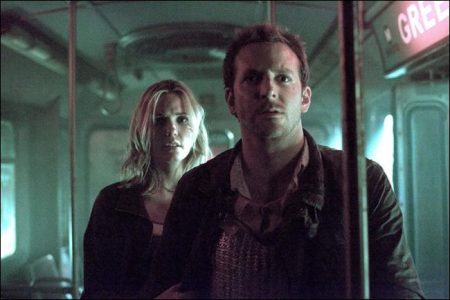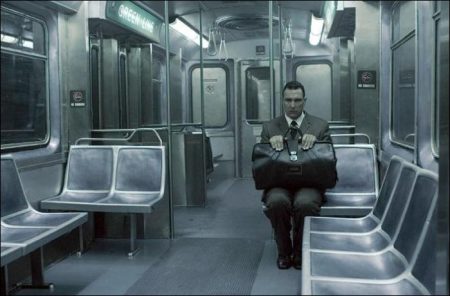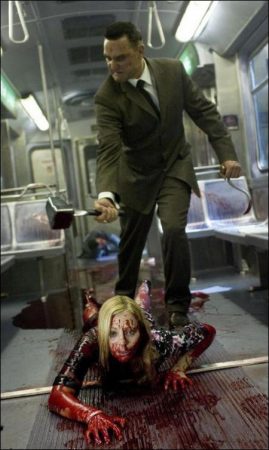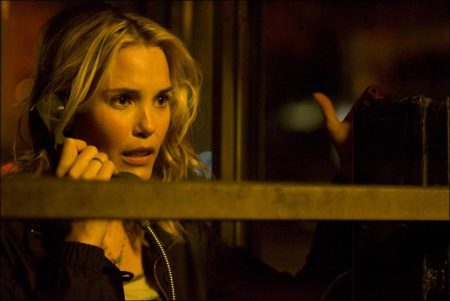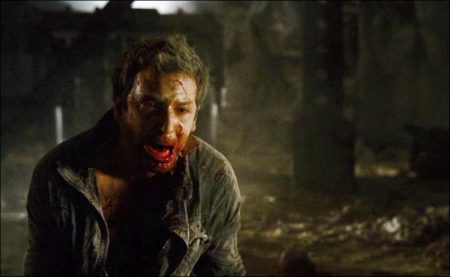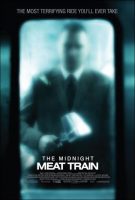Tagline: Next Stop… Death!
The Midnight Meat Train movie storyline. Based on Clive Barker’s short story. Bradley Cooper stars as an inquisitive photographer who comes across Mahogany (Jones), a butcher who uses the subway system as his killing floor. But who is he killing for and where is he delivering the meat of his victims?
When Leon Kaufman’s (Bradley Cooper) latest body of work – a collection of provocative, nighttime studies of the city and its inhabitants — earns the struggling photographer interest from prominent art gallerist Susan Hoff (Brooke Shields), she propels him to get grittier and show the darker side of humanity for his upcoming debut at her downtown art space.
Believing he’s finally on track for success, Leon’s obsessive pursuit of dark subject matter leads him into the path of a serial killer, Mahogany (Vinnie Jones), the subway murderer who stalks late-night commuters — ultimately butchering them in the most gruesome ways imaginable.
With his concerned girlfriend Maya (Leslie Bibb) fearing for his life, Leon’s relentless fascination with Mahogany lures him further and further into the bowels of the subways and ultimately into an abyss of pure evil – inadvertently pulling Maya right along with him.
Boarding the Train
Filming on The Midnight Meat Train’s 35-day shoot commenced March 18, 2007 in Los Angeles, but it was a long process before the film was put on track. The Midnight Meat Train is based on The Midnight Meat Train, a short story from Volume I of legendary horror writer Clive Barker’s best-selling Books of Blood collection. When Volumes I-III of Books of Blood were published in 1984, they prompted Stephen King to declare that Barker was “the future of horror,” a statement that would jumpstart Barker’s long, acclaimed career as a novelist, screenwriter and director.
Over the years, Barker has become one of the world’s most famous and honored writers. And during those years, The Midnight Meat Train has been one of – if not THE – most popular of his stories, and one that was always on fans’ wish lists for a movie adaptation. According the Barker, “Books of Blood were written back in the early eighties as my attempt to put into short story form all the wicked, dark ideas that I had had through my twenties. I really wanted to prove how broad a genre horror actually is. In the six volumes, I wanted to say, `Look, horror can be funny, it can be bloody, it can be subtle, it can be about the supernatural, it can be about the human heart, it can be so many things.’”
Barker was in New York in the late 1970s, a time when people were being murdered on trains. It was these news events that provided the initial creative spark for his story.
Barker notes that for the legions of fans, the essence of the original story is all there in the movie. “I don’t think anybody who likes the short story is going to be disappointed by the movie at all,” he assures.
Midnight Meat Train was the first story in the first volume of Books of Blood and it is one of the first stories Barker ever wrote. “It is a relentlessly horrific descent into madness and darkness and all things forbidden,” Barker says. “Joseph Campbell speaks of this being one of the primal forms – the idea of the hero descending into darkness, descending into the underworld, which our hero Leon does. The underworld happens to be below New York, but it’s the same thing.”
Barker hopes that the film will offer audiences an experience that will dare them to keep looking at the screen. And he notes that there is also a lot of character development in the film. “I think you’re going to care about these people,” he says. “We’ve got some wonderful performances and marvelous actors. It’s not a simple story. It’s a complex tale of somebody giving up their social identity and their identity as a lover to become something else, to become a servant of darkness, which is a choice we perhaps all sometimes have to make.”
To help adapt the original 27-page short story into a feature-length film, the studio turned to Jeff Buhler, who marks his first produced screenplay with The Midnight Meat Train, having previously written numerous original works.
An old friend of Clive Barker’s producing partner Joe Daley, Buhler had been trying to find a project with which to work with Barker for as long as he can remember. “I feel like a kid in a candy store,” he says, now that his desire had been fulfilled. “This is one of those things that came about where they were pondering going back to Clive’s original anthologies of short stories, Books of Blood. And Joe brought me a nice signed, collectors’ edition and said, `Go through these again and see if there’s a story there that strikes you as one you want to bring in as an idea for a film.’ And, and I said, `Thank you very much for the book. I’m definitely keeping this. But The Midnight Meat Train is the story I really want to tell.'”
In developing a structure for the screenplay, Buhler first set focus on the classic serial-killer story. But then he says, “There comes a moment when it turns a corner where you have absolutely no idea what is going on.”
As Buhler explains, “The movie The Midnight Meat Train follows a man’s obsession, a man who believes that he has stumbled upon a killer who’s terrorizing the city. And his obsession is manifested through his photography. This is one of the things that I brought to the screenplay that’s not in the short story. In the book we live in Leon’s head, and this works amazingly well in that form. But of course as a film we needed a way to see Leon’s obsession with the city, what goes on in the dirty alleyways, what goes on below the surface of the city. And to do that we made Leon a photographer so there was a visual means of seeing what was going on in his head. This photographer stumbles upon a man who he believes is terrorizing the city. He soon learns that there’s a lot more to that story than meets the eye and he becomes sucked into this underbelly of what’s going on below the city. That’s where the real Clive Barker-ness comes out.”
In addition to being a celebrated author and director, Clive Barker is also a celebrated and prolific painter. As such Barker did many drawings for The Midnight Meat Train that helped inform the look of the film. “I think it’s a good way to help a director share my vision,” Barker says.
To fulfill that vision, Lakeshore Entertainment enlisted Ryuhei Kitamura, a Japanese director who has garnered widespread international acclaim for his ultra-stylish thrillers and fantasies. With The Midnight Meat Train, Kitamura incorporates many of his signature visual styles and storytelling skills to the film.
Kitamura spent a long time looking for his first American movie project, having read nearly 50 scripts over the last five years. “Most of the scripts I’d received were just B horror movies and B action movies, which doesn’t interest me that much,” the director says. “I already made eight movies in the last five or six years and I think I survived because I always try to put my stamp one each one — even though I’m making some insane action movie like Versus, or a samurai movie like Azumi, or a Godzilla movie — I always try to make my world. I didn’t want to mess with my career by doing this just because it’s big budget, or just because it’s a Hollywood movie. So I was very careful about picking the right project.”
Lakeshore Entertainment Chairman/CEO Tom Rosenberg, who also serves as a producer on the film, notes that Lakeshore had the project for almost ten years before all the right pieces fell into place to head into production. The first choice was to find a director who could translate an iconic classic story into a modern, stylish film. “I think when you look at Ryuhei’s body of work, you will see this amazing combination.
He not only is this incredible action director who knows how to shoot a fight sequence or bring scares to the screen. But what’s really impressive is that there’s also a heart to them,” he says. “There’s so much of an emotional underpinning to all of his movies, such as Lovedeath or Azumi. There’s a wonderful sense of pacing and action, and at the same time a counterbalance of heart and life and love. And when that emotional tone is combined with the action, it’s really, really stunning.”
In 2006, Kitamura’s manager set up a meeting with Lakeshore Entertainment’s Tom Rosenberg and Gary Lucchesi. Lucchesi told Kitamura they were doing a movie of The Midnight Meat Train and asked if he was familiar with it. “Of course I knew it,” Kitamura says. “It was Clive Barker! I read this original novel exactly twenty years ago, the first Clive Barker book published in Japan, back in 1987. I got the book on the first day it came out and read it. I just loved it.” Kitamura still owns the twenty-year-old Japanese first edition.
The executives at Lakeshore gave the director a copy of the script to read, and asked he let them know what I thought. “So I read the script and thought it was good, very good” enthuses Kitamura. “I’m a big fan of Clive Barker so I couldn’t resist. Clive has an endless, huge imagination inside his mind. I felt this was a great opportunity.”
Kitamura expands, “I think this is one of the most gory, bloodiest movies ever made. It is a scary movie, but it’s not just about death. It’s about the great relationship between Leon and Maya, which is why I’m doing this. I’m not interested in just showing the blood and gore and splatter; there are too many movies like that. I need story and character and relationship, and this script had all that. So I tried to build that unique vision with my crew, my cast, my producers. I think that is how I put a little bit of my own blood into my film. Technically-speaking, since day one we’ve been not to have a single shot in the movie looks like something else. Everything should be something you’ve never seen before — the angles, the lenses, the camerawork, the look — everything should be something original.”
With a director on board, the production was all set to move forward. But first the filmmakers had to find the ideal actors to play the pivotal roles of Leon, Mahogany, and Maya.
Kitamura explains that the character of Leon “is a guy who tries to capture the truth, the essence of the city, what the city really is. He’s trying hard to find the truth that lies beneath the surface of the city. He steps into the darkness and discovers, little by little, this secret mystery among the people and by the time he realizes the truth it’s too late for him to go back. He just goes deeper and deeper and in the end he gets on this mysterious train and finds the truth.”
To portray the role of Leon, the filmmakers chose Bradley Cooper, a rugged leading man best known for his performances on the hit television series “Alias” and his supporting role in the comedy smash hit Wedding Crashers.
As a Clive Barker fan and a fan of the genre, Bradley Cooper was thrilled to take on the role of Leon. “The script was a really cool,” he says, “and the chance to work with Vinnie Jones interested me. I’d also seen several of Ryuhei Kitamura’s movies from Japan and thought working with him would be a really good experience. Ryuhei is the reason why the movie might be completely innovative. He has a completely unique, individual take. The shooting style, the way it’s shot is very unorthodox for the genre. It’s a lot of long lenses and almost French Connection-looking, which I think is going to be pretty cool.”
Cooper was equally intrigued by the storyline and all its twists and turns. “The thing that’s different about this movie than other movies of this type is that usually the protagonist is on the hunt for the antagonist. And in this movie those lines are blurred. It’s weird because Leon starts to stalk this guy Mahogany. But then you notice that the guy is almost aware that Leon is stalking him and almost wants him to. I really liked that idea.
Leon is initially just tracking this guy and trying to figure out what he’s up to. He realizes that this meatpacking plant that Mahogany works at has been around since the 19th century, and that in fact there was a case in the ’20s or ’30s where cannibalism was going on and this guy was arrested. And he somehow thinks that there’s a link between what that guy and Mahogany are doing. But what he doesn’t realize is that it’s so much bigger than that, and that in fact Leon was `chosen,’ perhaps before the movie even starts. It becomes very supernatural as it progresses.”
Lakeshore President of Entertainment and The Midnight Meat Train producer Gary Lucchesi says, “I found myself completely intrigued by Bradley Cooper’s performance. I never knew where Bradley was going as Leon, and as a result I discovered Leon through him. He brought a real uniqueness and freshness to a character that I thought I was already familiar with.”
To balance Cooper’s Leon, the filmmakers set the goal of creating a new horror icon. “From day one in developing the script, Clive and I had this drive to create a new personification of horror,” says Kitamura. “I’m a big fan of the genre myself; I have binders and figurines of Michael Myers, Freddie Krueger, Jason Voorhees, Leatherface, Pinhead, Ash from `Evil Dead’- all those great characters from the eighties. Characters like these haven’t been seen for twenty years.”
“I was initially considering casting Mahogany,” continues the director, “with someone from the eighties – maybe like bringing back an eighties superstar or someone like that. But the producers were thinking of an unknown because they felt that if we cast somebody famous it would distract from the movie. Then I heard that Vinnie Jones had read the script and he was interested in the part. I knew right then we had to cast Vinnie.”
“When we considered Vinnie Jones for the role,” says Gary Lucchesi, “not one of us in the room didn’t say, “That’s it!’ It’s just this amazing kind of marriage, because Vinnie is known for so many different things and so many different types of heavy characters that he plays. We immediately imagined Vinnie Jones in that dapper brown suit and the short hair, becoming the embodiment of evil.”
Following in the footsteps of such horror legends as Krueger, Voorhees, and Myers, Vinnie Jones knew that with this role, he had the opportunity to create an equally iconic character in Mahogany. “I knew that if you can make the right movie, the right serial killer, you can become a legend,” says the former UK soccer star turned actor. “And like some of those characters, Mahogany has the interesting and challenging trait of not uttering a word during the film. “If the role has any downfall, it’s that I haven’t got any dialogue,” Jones adds. “But I’m trying to express it in different ways. Instead of remembering dialogue, you’re remembering mannerisms.”
The chiseled, physically intimidating star of films such as Lock, Stock and Two Smoking Barrels and Snatch, Vinnie Jones says that what also appealed to him about the film was that it presented characters and story that were a cut above the recent spate of horror films — “torture porn” as it’s often called — that have become so prevalent in today’s horror movies. “It’s not one of those movies that’s just snapping fingers off and cutting toes off,” Jones explains. “It’s about the story and the characters and what happens along the way. I think people that love horror will be attracted to that side of it, but there is also a compelling story that you can follow. And we bring it all together along with some great twists and mystery as well.”
The third wheel of The Midnight Meat Train is Maya, Leon’s girlfriend, who serves not only as an integral part of the story, but is also in essence the objective viewer who gives the closest approximation of the audience’s viewpoint to the horror that is unveiled.
Maya is played by Leslie Bibb, who was most recently seen in the first blockbuster of Summer 2008 Iron Man, starring Robert Downey Jr. and Gwyneth Paltrow; starred opposite Will Ferrell in the hit comedy Talladega Nights: The Ballad of Ricky Bobby, and in the horror film Trick’r Treat. Though not generally a fan of horror movies, Bibb instantly fell in love with the character of Maya and how she fit into the story.
“I’ve never really technically seen a horror movie in entirety because I’m such a pansy,” she laughs. “So when I read it I was, like, `Uh oh, I’m in a little bit of trouble,’ because I just loved Maya. I loved her journey through this story. And the love story in this movie is not the usual thing you see in this sort of film. If you’re just doing a horror movie with blood and guts, that’s scary. But there’s got to be something else too. It’s almost like a Greek tragedy because of what happens. To watch this couple and to watch Leon’s journey as he essentially dies, I mean, not literally but figuratively dies inside. I thought it was really exciting.”
Maya is the heart of The Midnight Meat Train,” notes Lucchesi. “She’s the heart of where this movie starts and when we get to the descent, we measure that tragedy by how Maya’s reacting to watching this guy who she loves slip away from her. And I think that’s what’s so compelling. She and Bradley have such a wonderful chemistry together, which is really exciting to watch.”
For Leslie Bibb, the opportunity to work with such visual stylists as director Ryuhei Kitamura and his director of photography Jonathan Sela was extremely alluring. “They’re a force to be reckoned with because their vision is amazing,” Bibb enthuses. “It almost feels a little noir, due to some of the shots they created and the choices they made with placement of the camera. It feels like so much more than just a horror movie. And I think it’s going to really scare the crap out of you, which is always good. That’s what you want with a horror movie.”
“What Ryuhei has done with his interpretation is really capture the heart and the essence of the story between Leon and Maya, which is the entry point into this world,” says Lakeshore’s Tom Rosenberg. “He’s done it with such tenderness that we all can connect with these characters. Once we’re there, he completely spins it in a different direction and takes us down into this descent of decay and discovery. The world into which we enter is a world into which we don’t want to go, yet we can’t help but go. It’s so dark we can’t help but be intrigued. Ryuhei masterfully pulls us into that world and completely entraps you into that moment.”
Building believable, empathetic characters was a key for Ryuhei Kitamura in crafting a classic horror film. “If you don’t care about the character, then you don’t care if they get tortured or killed or get their heads chopped off. With most horror movies, we don’t care about the characters. You see lots of horrible things all over the world every day but you don’t care because it’s somebody you don’t know. It becomes scary when someone you care about is in danger. That’s why I want the audience to care about Leon and Maya.”
“What I love about Maya is that initially she is Leon’s biggest fan and biggest supporter, but then she really starts to doubt him and starts to lose him,” Bibb explains. “And the fire she gains to just save him, you know, she really tries to save the person that she loves most in the world because she’s watching him disappear. She goes from sitting on the sidelines to being part of the game.”
In a stroke of unconventional casting, Brooke Shields plays art gallerist Susan Hoff, a friend of Maya’s who ultimately gives Leon the opportunity to show his photographic work at her downtown gallery. Shields, a renowned actress since her youth, is most recently known for her starring role on the NBC television series “Suddenly Susan,” “Nip/Tuck” and most recently “Lipstick Jungle.”
Shields points out that she made her debut as an actress in a horror movie at the age of nine, but hasn’t done one since. “I’m a fan of this type of genre film, even though I get really scared watching them,” she says.
However, Shields was intrigued about playing a gallery owner who also has predator instincts. “Everybody’s really afraid of her, and it’s a big deal if you get to show in her gallery,” she says. “She has very specific tastes. And she’s not afraid to push the envelope-and push everyone around her too. At first I’m not impressed with Leon’s photography but then I end up getting sort of wowed by it because it’s uncomfortable. The darkness in the photography is something that I respond to.”
Shields continues, “I think of the film as a metaphor for the underbelly, where this life force that has been growing and accumulating for years and perhaps forever. My character doesn’t get to go on the actual journey with them, but I’m throughout, sort of on the outside discussing what the artistry is really about. Much like Clive Barker’s paintings — they take a step beyond what you normally would see. Susan wants to see the darker side, the side that’s uncomfortable, the side that makes you want to close your eyes and turn away. I’m the one that sort of says, `I want you to go further. Don’t be safe. Don’t play it safe in any way.’”
Rounding out the main cast of The Midnight Meat Train are a talented group of supporting actors including Scottish actor Tony Curran (Underworld: Revolution) as the driver, Roger Bart (Hostel: Part II as Leon’s art reviewer friend Jurgis; and Ted Raimi (Spiderman 3, Reign Over Me) as a tourist on the train.
UFC mixed martial arts champion Quinton “Rampage” Jackson also appears in a memorable train fight sequence with Mahogany. “The idea behind casting Rampage in the movie was that this is the only character that really can come close to stopping Mahogany,” notes producer Gary Lucchesi. “That maybe Mahogany has messed with the wrong guy is a little bit of an inside joke for those of us who know who Rampage is. When casting him, we learned that he was interested in doing something funny in the movie and we saw that as a real opportunity.”
Tom Rosenberg hopes that The Midnight Meat Train will set a new tone for horror movies. “Every kind of preconceived notion that we have about horror movies in terms of tone, action, blood, in terms of the beats that lead up to the horror, the beats that happen after; this movie takes those very familiar, very conventional aspects and turns them on their side. We are doing something that’s slightly different, doing something that is going to give the audience something new and something refreshing, and hopefully that’ll translate into a lot of people enjoying the movie.”
To sum up, Clive Barker hopes that audiences “leave the theaters with their seats damp,” he chuckles. “I want them to lose control of their bladders with terror. But, you know, I really want them to come out and say, `That was the ride I wanted it to be. That was the journey I wanted to take. I took a journey into the dark.’ And, you know, one of the things horror does is it allows you to face your fears in a safe form and survive. You watch other people die and you think, `Hey, it wasn’t me.’ I think this movie is going to take people to a very, very dark place and deliver them at last out into the night, out into the day, feeling like they survived quite a ride.”
# # #
Much of The Midnight Meat Train was filmed on trains, both real trains at several downtown Los Angeles County Metro Rail stations, and fixed train cars situated on stage at the film’s stage and office base in Sun Valley near Burbank.
Two Metro stations were utilized for the practical train sequences in the film, notably the ultra modern Los Angeles City College station underground at Santa Monica & Vermont, which provided the setting for the confrontation between Leon and a group of gangbangers on an escalator. In those scenes he rescues a young Asian woman played by Norika Sato, who is also the star of director Ryuhei Kitamura’s recent Lovedeath. The other stations was the MTA Redline station on 5th and Hill.
A warehouse with an old train platform in San Pedro was the location for the deserted subway platform located beneath the meat plant. On stage in Sun Valley, the filmmakers brought in two full-size train cars that were placed on a rocking gimbal to simulate the train’s movement. As a note of trivia, these train cars were also utilized in scenes featuring Doc Ock in Spider-Man 2.
For the train sequences, Oscar-winning prosthetic effects designer Matthew Mungle (Bram Stoker’s Dracula) was charged with creating all the prosthetic effects. For the three-time Oscar nominee who currently does all the special makeup effects for “CSI: Crime Scene Investigation,” the allure of this movie was because it was creature-oriented. “I hadn’t really done a creature movie for a long time, so I thought it would be a good chance to do something like that again,” Mungle notes.
For Mungle and his team, the main part of his job was to create the bodies of Mahogany’s victims on the train. “We did a lot of nude bodies,” Mungle says. “Initially, it was as if they were skinned down to the musculature. Then the filmmakers changed it, and the bodies were just nude, hanging upside down. So it actually became harder to do that than it would have been to just do the skinned and the musculature because we were just going to take regular bodies, foldable, pose-able bodies and just build them up with muscles. But they changed it to completely nude bodies, so we had to start from scratch, casting actors that production supplied to us, the bottom halves and then the upper torsos, so we could put them together and make them seamless. It became a little bit more difficult for us, but in the end it worked out great.”
One of the more intricate effects designs was when Mahogany decapitates a female tourist on the train. “You don’t see the actual decapitation, but you see the aftermath of the head laying there, the body pumping the blood, the hand twitching,” Mungle notes. “So we took a stock body and added the neck and the twitching hand, and cast the actress’ head to make a duplicate head of her with her eyes open and her mouth open in a screaming position.”
Emanating from a story collection entitled Books of Blood, it’s not surprising that the filmmakers used gallons upon gallons of fake blood in Mahogany’s killing train. “I honestly think that there is more blood in this film than I’ve ever seen in a horror movie,” Vinnie Jones states. “They’re just bringing in gallons and gallons and throwing it around. Every time in the fight scenes we’re hitting and there’s blood splattering everywhere and it’s really uncomfortable to work with. But you just got to keep telling yourself `it’s all for the fun of the end product,” because it’s messy as hell in there!”
In addition to the dark, sinister settings of Mahogany’s apartment and the various train stations, Mahogany carries with him a satchel embroidered with his name and filled with all kinds of devilish killing instruments. “He carries this briefcase around and that has his tools in it, but number one weapon is this big steel hammer,” says Vinnie Jones. “That’s how he starts everything off — he whacks `em with that and then all hell breaks loose.”
Mahogany’s bag was designed by property master John Keim, based on its description from the Clive Barker short story. “The bag started its life as a US Air Force issue bag,” Keim offers, “and I redesigned it based on a veterinarian’s bag from the 1800s.” According to Keim, inside the bag he placed everything the well-tooled psycho killer would have in his bag. “I’ve got the ankle hook with which you can pierce the victims and hang them up in the air. And then you just whip out your knife and carve their skin. Plenty of knives in here for any direction you want to go! We’ve got a real steel hammer as well as several rubber hammers of different weights with which to smash people and things. We even have hammers that don’t have heads on them, so that when it goes through a person’s skull, the visual effects guys will just add the upper half of the hammer. We’ve got the fingernail puller and a lot of different pulling devices. There’s even an eyeball separator puller-outer.”
A large artist’s studio in the mid-city area of Los Angeles served as the prestigious downtown art space where gallerist Susan Hoff, played by Brooke Shields, offers Leon inclusion of his edgy photographs into a prominent group show.
For the gallery scene, many of the paintings hanging in the space are the works of Clive Barker. “The producers asked me if I would like to put some paintings into the gallery scene, and I said, `Hey, why not?,’” Barker recalls. The film’s art director chose the pictures from Barker’s seven hundred-picture collection based on which ones were tonally right for the movie.
Other locations included various city streets and alleyways in downtown Los Angeles, as well as the exterior of Main Street’s Hotel Barclay, that portrays Mahogany’s hotel in the film; Quality Café in downtown Los Angeles portrayed Otto’s restaurant, and Manning Beef, a meat packing plant in Pico Rivera provided the locale for the plant where Mahogany works.
The Midnight Meat Train (2008)
Directed by: Ryuhei Kitamura
Starring: Bradley Cooper, Vinnie Jones, Brooke Shields, Leslie Bibb, Roger Bart, Peter Jacobson, Barbara Eve Harris, Ted Raimi, Quinton ‘Rampage’ Jackson, Donnie Smith, Earl Carroll
Screenplay by: Clive Barker
Production Design by: Clark Hunter
Cinematography by: Jonathan Sela
Film Editing by: Toby Yates
Costume Design by: Christopher Lawrence
Set Decoration by: Andi Brittan
Art Direction by: Lisa Vasconcellos
Music by: Johannes Kobilke, Robbie C. Williamson
MPAA Rating: R for sequences of strong bloody gruesome violence, grisly images involving nudity, sexual content, language.
Distributed by: Lionsgate Films
Release Date: August 1, 2008
Views: 86
